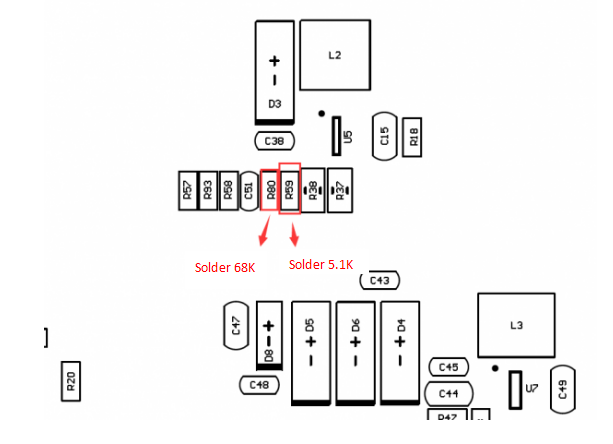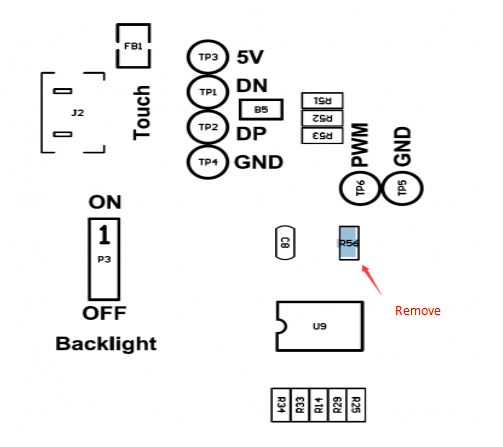7inch HDMI LCD (B)
| ||
Overview
Introduction
7inch Capacitive Touch Screen LCD, HDMI interface, with a resolution of 800 × 480 and a capacitive touch panel, which supports Raspberry Pi and can also be used as a computer monitor.
| More |
Features
- 800 × 480 hardware resolution.
- 5-point capacitive touch control.
- When used with Raspberry Pi, supports Raspberry Pi OS/Ubuntu/Kali and Retropie.
- When used as a computer monitor, supports Windows 11/10/8.1/8/7.
- Support backlight control, saving more power.
Working with PC
This LCD can support Windows 7/8/8.1/10/11 system.
How to use:
1) Turn on the backlight switch on the back of the LCD.
2) Connect the Touch interface of the LCD to the USB interface of the PC. Wait for a while, the windows will automatically recognize the touch function.
3) Connect the HDMI interface of the LCD to the HDMI interface of the PC.
Note:
1) When the computer is connected to several different displays at the same time, only this LCD can be used to control the cursor on the main display, so we recommended to set this LCD as the main display.
2) Some PCs do not support plug-and-play with HDMI devices. Generally, they can be used normally after restarting the system.
3) Some PCs may cause LCD flickering due to insufficient power supply through the USB interface. Generally, they can be used normally after connecting to an external 5V/2A power supply through the DC interface.
Working with Raspberry Pi
This LCD can support Raspberry Pi OS / Ubuntu / Kali and Retropie systems. When the LCD works on systems such as Raspberry Pi OS, the resolution must be set manually, otherwise, it will cause an abnormal display.
Please download the latest version of the image on the Raspberry Pi official website.
1) Download the compressed file to the PC, and unzip it to get the .img file.
2) Connect the TF card to the PC, and use SDFormatter software to format the TF card.
3) Open the Win32DiskImager software, select the system image downloaded in step 1, and click 'Write' to write the system image.
4) After the image has finished writing, open the config.txt file in the root directory of the TF card, add the following code at the end of config.txt, then save and quit the TF card safely.
hdmi_group=2 hdmi_mode=87 hdmi_cvt 800 480 60 6 0 0 0 hdmi_drive=1
5) Insert the TF card into the Raspberry Pi
6) Turn on the backlight switch on the back of the LCD.
7) Connect the Touch interface of the LCD to the USB interface of the Raspberry Pi.
8) Connect the HDMI interface of the LCD to the HDMI interface of the Raspberry Pi, power on the Raspberry Pi, and wait for a few seconds until the LCD displays normally.
EDID Sequence Parameters
If the system of the main control board can automatically recognize the EDID for display, there is no need to additionally set related timing parameters.
Otherwise, you can refer to the following EDID settings:
| Pixel Clock | H Addressable | H Blanking | V Addressable | V Blanking | H Front Porch | H Sync Width | V Front Porch | V Sync Width | H Image Size | V Image Size | H Border | V Border |
|---|---|---|---|---|---|---|---|---|---|---|---|---|
| 32.00 | 800 | 128 | 480 | 45 | 40 | 48 | 13 | 3 | 108 | 68 | 0 | 0 |
Resources
Drawings
Installation Tutorial
Software
FAQ
Add the following commands at /boot/config.txt:
disable_splash=1
{{{5}}}
Replace it with the picture in /usr/share/plymouth/themes/pix/splash.png.
{{{5}}}
Test environment: 2022-04-04-raspios-bullseye-armhf 32-bit system
Supported models: Support Waveshare DSI LCD, DPI LCD and HDMI LCD capacitive touch screen series.
Software Installation
wget https://www.waveshare.com/w/upload/1/18/Evdev-right-click-emulation.zip unzip Evdev-right-click-emulation.zip cd evdev-right-click-emulation sudo apt install build-essential libevdev2 libevdev-dev cd 'evdev-right-click-emulation' sudo cp 'out/evdev-rce' '/usr/local/bin/' sudo chmod +x '/usr/local/bin/evdev-rce'
Enter the command:
sudo evdev-rce
After running, you can touch and long press to realize the right-click function.
Set IP
sudo usermod -G 'input' -a pi echo 'uinput' | sudo tee -a /etc/modules sudo nano /etc/udev/rules.d/99-uinput.rules
Add in 99-uinput.rules file.
KERNEL=="uinput", MODE="0660", GROUP="input"
save it and run it in the terminal.
sudo udevadm control --reload-rules sudo udevadm trigger
Then reboot:
sudo reboot
Run after reboot (no sudo needed at this point)
evdev-rce
After running, you can touch and long press to realize the right-click function.
Set Startup
Enter the terminal
sudo mkdir ~/.config/autostart sudo nano ~/.config/autostart/right_click.desktop
Add the following in right_click.desktop.
[Desktop Entry] Version=1.0 Type=Application Name=evdev-rce GenericName=Enable long-press-to-right-click gesture Exec=env LONG_CLICK_INTERVAL=1000 LONG_CLICK_FUZZ=200 /usr/local/bin/evdev-rce Terminal=true StartupNotify=false #If you want to modify the sensitivity, you can modify the size of the two parameters, LONG_CLICK_INTERVAL=1000 LONG_CLICK_FUZZ=200.
{{{5}}}
{{{5}}}
Depending on the system, if there's a sleep function, the screen might go black when it activates. The official Raspberry Pi OS typically enters sleep mode after around ten minutes of inactivity.
{{{5}}}
- Edit the config.txt and add this line at the end of the config.txt file:
hdmi_drive=1
{{{5}}}
{{{5}}}
{{{5}}}
As shown in the figure below, change serial number 2 to 68K resistor, serial number 3 to 5.1K resistor, and remove serial number 1 resistor.
Then connect the PWM pad to the P1 pin of the Raspberry Pi.
Execute the following command on the Raspberry Pi terminal:
gpio -g pwm 18 0 gpio -g mode 18 pwm (occupied pins are PWM pins) gpio pwmc 1000 gpio -g pwm 18 X (X ranges from 0 to 1024), 0 is the brightest, 1024 is the darkest
As shown in the diagram below, solder R80 to a 68K resistor instead, R59 to a 5.1K resistor, and remove the R56 resistor.
Then connect the PWM pad to the P1 pin of the Raspberry Pi.
Execute the following command in the Raspberry Pi terminal:
gpio -g pwm 18 0 gpio -g mode 18 pwm (occupied pins are PWM pins) gpio pwmc 1000 gpio -g pwm 18 X (X value between 0 and 1024), 0 is the brightest, and 1024 is the darkest.
{{{5}}}
Anti-Piracy
Since the first-generation Raspberry Pi released, Waveshare has been working on designing, developing, and producing various fantastic touch LCDs for the Pi. Unfortunately, there are quite a few pirated/knock-off products in the market. They're usually some poor copies of our early hardware revisions, and comes with none support service.
To avoid becoming a victim of pirated products, please pay attention to the following features when purchasing:
Beware of knock-offs
Please note that we've found some poor copies of this item in the market. They are usually made of inferior materials and shipped without any testing.
You might be wondering if the one you're watching or you've purchased in other non-official stores is original, feel free to contact us.
Support
Technical Support
If you need technical support or have any feedback/review, please click the Submit Now button to submit a ticket, Our support team will check and reply to you within 1 to 2 working days. Please be patient as we make every effort to help you to resolve the issue.
Working Time: 9 AM - 6 PM GMT+8 (Monday to Friday)





